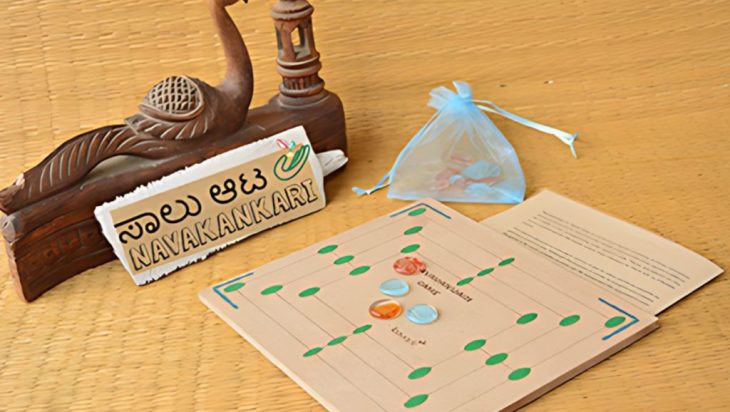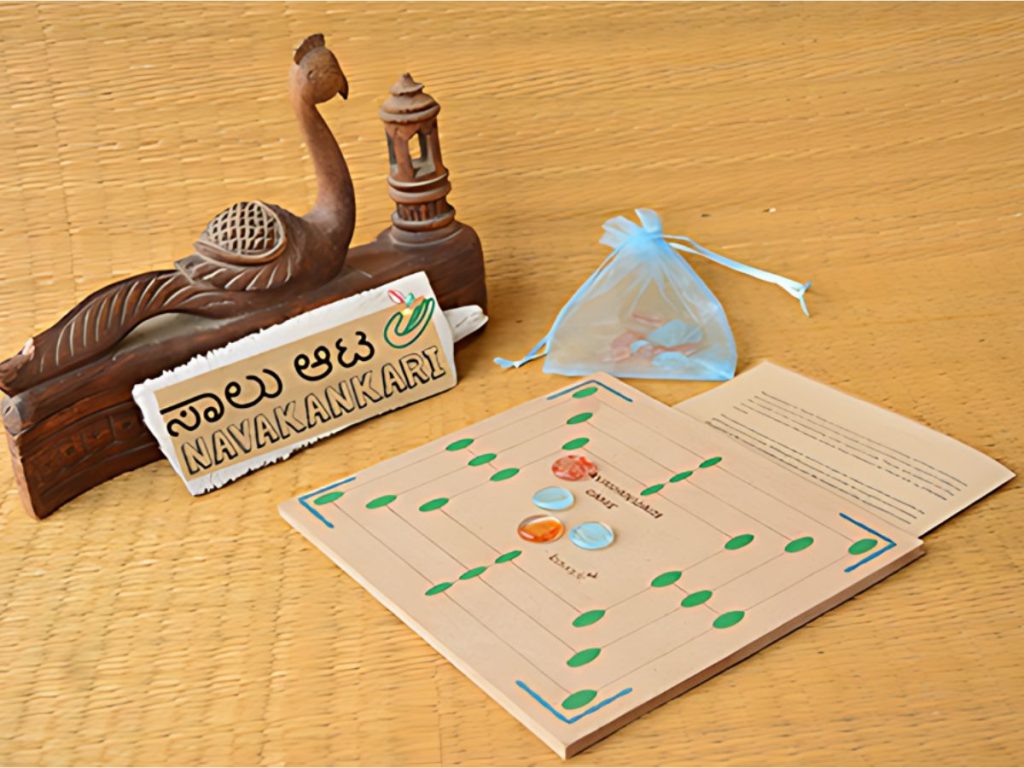Navakankari: The ancient and enduring legacy of Nine Men’s Morris

Prepend to the content

Navakankari, also called Nine Men’s Morris, is a strategy board game that started in the Roman Empire. Historical records mention it, and it has been found at archaeological sites from around 1400 BCE. The game became very popular in Europe during the Middle Ages and was often carved into stones of cathedrals and castles. It was enjoyed by both rich and common people as a fun and strategic activity.
The game spread widely from Europe, influencing board games in many cultures. It was taken up and changed in different ways in countries like England, France, Italy, and Germany. Versions of the game have also been found in Africa, Asia, and the Americas, showing its broad appeal and adaptability. Each place added its own unique rules, reflecting local cultural traditions.
A clay tile fragment from the archaeological museum at Mycenae appears to show a Nine Men’s Morris board. R. C. Bell claimed that the earliest known board, featuring diagonal lines, was carved into the roofing slabs of the temple at Kurna in Egypt and dated around 1400 BCE. However, Friedrich Berger noted that some diagrams at Kurna include Coptic crosses, making it uncertain if they date back to 1400 BCE. Berger concluded that these diagrams cannot be definitively dated. The Coptic crosses themselves date no earlier than 42 CE, according to Coptic Orthodox tradition, which is close to the end of the temple’s known architectural development. Nonetheless, the earliest known board for the game certainly predates the Common Era, as will be explained further in this article.
One of the earliest mentions of Nine Men’s Morris may be in Ovid’s “Ars Amatoria.” In Book III (around 8 CE), after discussing a popular board game called latrones, Ovid wrote about another game divided into as many parts as there are months in the year. He described it as a game where players must get three pieces in a straight line, suggesting it was important for women to know how to play, as love often blossomed during the game.
Berger believes the game was likely well-known among the Romans since many boards have been found on Roman buildings, although dating them is difficult due to their accessibility. It is possible that the Romans encountered the game through trade routes, but this remains unproven.
An illustration from the 13th-century “Libro de los Juegos” shows the game being played with dice. A 1735 German gaming table at the Cleveland Museum of Art features chess/draughts on one side and Nine Men’s Morris on the other. The game might have been played by sculptors while building large temples, with many inscriptions carved on stone. It peaked in popularity in medieval England. A brick from a medieval site near Wisbech, used by brickmakers as a game board before firing, has been found. Boards carved into cloister seats have been discovered at English cathedrals like Canterbury, Gloucester, Norwich, Salisbury, and Westminster Abbey, where they used holes instead of lines, leading to the name “nine holes,” and forming a diagonal row did not win the game. Another board is carved into a pillar base in Chester Cathedral. Giant outdoor boards were sometimes cut into village greens. In Shakespeare’s “A Midsummer Night’s Dream,” Titania mentions such a board: “The nine men’s morris is filled up with mud.”
The origin of the game is uncertain. Some speculate its name might be linked to Morris dances and hence to Moorish origins, but Daniel King argues that “morris” comes from the Latin word “merellus,” meaning a counter or gaming piece. King also notes the game’s popularity among Roman soldiers. In some European countries, the board’s design was considered a symbol of protection from evil.
The game is played on a board consisting of three concentric squares connected by lines running along the midpoints of their sides, forming a grid. Each player has nine pieces, traditionally called “men,” and the objective is to form ‘mills’—rows of three aligned pieces. The game has three phases: placing the pieces, moving them, and the endgame where the player aims to reduce the opponent to two pieces or block all their moves. The strategic depth of Navakankari lies in both the placement and movement of pieces, demanding foresight and planning.
How to Play?
Nine Men’s Morris is played on a board with three concentric squares connected by lines, forming a grid with twenty-four intersections. Each player has nine pieces, called “men,” usually in black and white. The goal is to form ‘mills’—rows of three aligned pieces—which allows the player to remove one of the opponent’s pieces. A player wins by reducing the opponent to two pieces or blocking all their moves.
The game has three phases:
Phase 1: Placing Pieces
- The game starts on an empty board.
- Players take turns placing their pieces on any empty intersection.
- When a player forms a mill by aligning three of their pieces horizontally or vertically, they can remove one of the opponent’s pieces. However, a piece in an opponent’s mill can only be removed if no other pieces are available.
- Once all pieces are placed, the game moves to phase two.
Phase 2: Moving Pieces
- Players take turns moving their pieces to adjacent points.
- Pieces cannot jump over others.
- Players continue to form mills and remove opponent’s pieces.
- If a player cannot move any pieces, they lose.
- A player can break a mill by moving a piece out of it and then moving it back to form the mill again, each time removing an opponent’s piece.
- When a player is reduced to three pieces, phase three begins.
Phase 3: Flying
- When a player has only three pieces left, they can move their pieces to any empty point on the board, not just adjacent ones.
- This rule, known as “flying,” helps balance the game when one player is close to losing.
Different sources have varying rules about flying, with some considering it a standard part of the game, others treating it as a variation, and some not mentioning it at all. A 19th-century manual referred to it as the “truly rustic mode of playing the game.” Flying was introduced to give a weaker player a chance to make a comeback.
At the beginning of the game, it’s more important to place pieces in versatile locations rather than trying to form mills immediately. Avoid concentrating your pieces in one area of the board. A good strategy is to aim for a position that allows you to move one piece back and forth between two mills, which lets you remove an opponent’s piece every turn. This typically leads to a win.
Navakankari: Different Names Around the World
Three Men’s Morris
Also called nine-holes, this variant is played on a grid of 2×2 squares or 3×3 squares, similar to tic-tac-toe. Each player has three pieces. Players take turns placing their pieces on the board, aiming to form a mill to win. After placing all pieces, players move their pieces according to one of these rules:
- To any empty position.
- To any adjacent empty position.
A player wins by forming a mill. H. J. R. Murray calls the first version “nine holes” and the second “three men’s morris” or “the smaller merels.”
Six Men’s Morris
In this version, each player has six pieces, and the game is played without the outer square of the nine men’s morris board. Flying is not allowed. This game was popular in Italy, France, and England during the Middle Ages but became obsolete by 1600. The same board is used for five men’s morris (also called smaller merels) and seven men’s morris, which includes a cross in the center.
Twelve Men’s Morris
Main article: Morabaraba
This variant adds four diagonal lines to the board and gives each player twelve pieces. The board can be completely filled during the placement stage, resulting in a draw. This version is popular among rural youth in South Africa, where it is known as morabaraba and is recognized as a sport. H. J. R. Murray also calls it “the larger merels.” The board is also used for eleven men’s morris.
Lasker Morris
Also known as ten men’s morris, this variant was invented by Emanuel Lasker, chess world champion from 1894 to 1921. It follows the rules of nine men’s morris with two key differences:
- Each player has ten pieces.
- Players can move their pieces during the first phase, choosing to either place a new piece or move an existing piece.
This variant is more complex than nine men’s morris and is less likely to result in a draw.
The post Navakankari: The ancient and enduring legacy of Nine Men’s Morris appeared first on G2G News.



